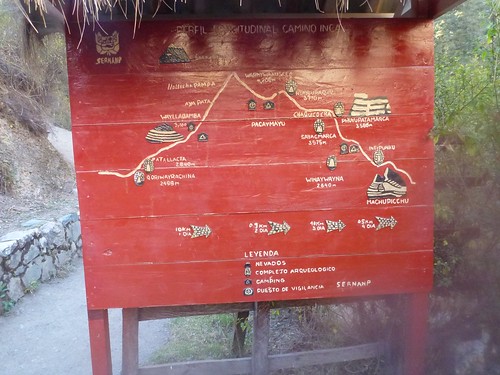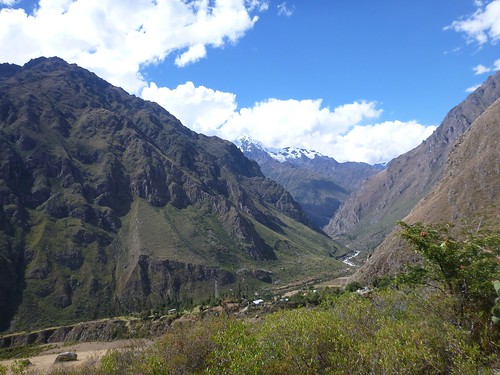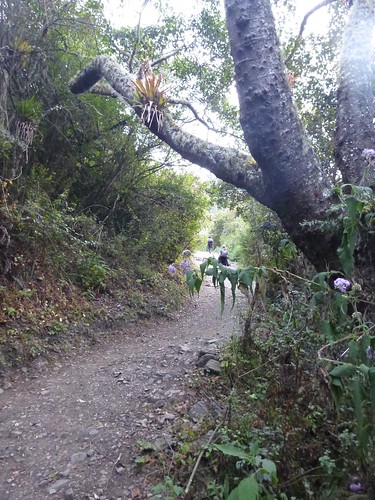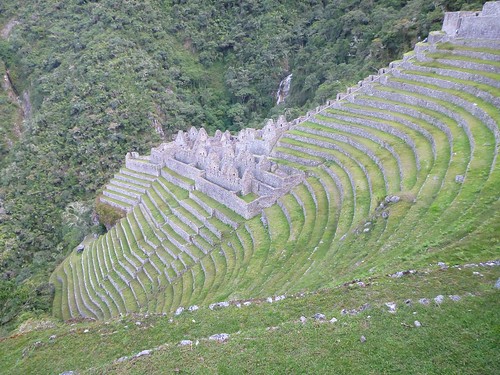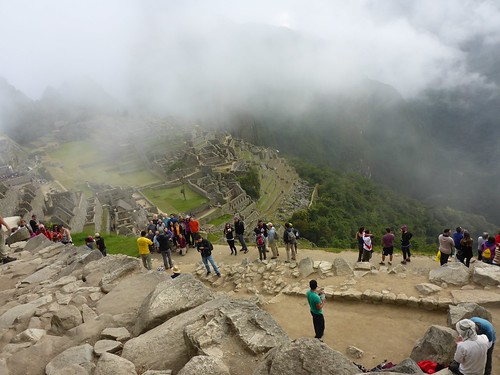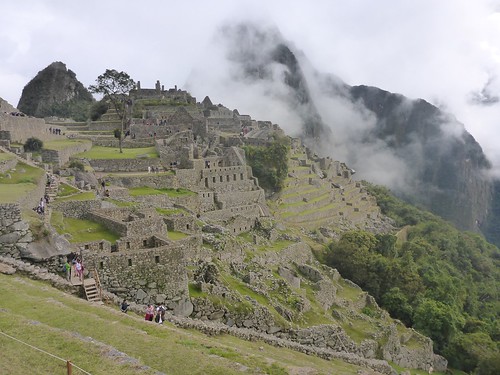Mountains and rocks and stairs, oh my! No lions, tigers or bears.
¡Hola, Stupid o’clock in the morning! Up and barely awake for our first day of driving and hiking the Inca Trail. We were piled into a bus with a bunch of sleepy travellers, ready to start the couple of hour drive to Ollantaytanbo. Eager to get going (or sleep on the bus, as it were) we needed to hurry up and wait; four of us had asked for poles and sleeping bags, which were supposed to be collected from the warehouse the night before, but hadn’t, and it was half an hour away.
After waking up a little bit, we got chatting to the rest of our tour group on the bus. There was another Australian couple, Brendan and Tess, who were only doing the Inca Trail part of the tour like us, and the rest of the group, Weng-Si, Bridget, Sam, Hannah, Jacqui and Mel who were doing the hike as part of a larger tour of Peru. Arriving off the bus to the Ollantaytanbo we stocked up on last minute supplies including a new beanie and gloves for Dee, and a half-decent cup of coffee before heading into the wilderness. José and Katie, our guides, then took us through to our first checkpoint at Piscacucho to get our permits and passports checked, and then and sent us on our way for our first full day of hiking.
During the morning, we started following the Urubamba River and staying fairly flat with some slight uphill bits. We stopped fairly regularly for quick water (and breathing) breaks, and José talked a bit about the trail and showed us what Cochineal beetles were by giving two of the girls some red “war paint” stripes.
After a couple of hours, a snack break and a couple of toilet breaks we stopped in for lunch, where the porters had set up a tent for us, tables, chairs and even a little portable potty – much more than what we’d expected! Sitting down for lunch thinking we might get a quick sandwich and a piece of fruit, we were rather surprised to be receiving a three-course meal of asparagus soup, salad, which included avocados picked fresh from one of the trees on the trail, and fresh bread, topped off with tea and coffee. It appeared we were going to be five-star camping on this trek.
Walking a lot further along the trail, we passed some more local villages on the path, in case we wanted to buy anything (at crazy prices) we had forgotten. The last part of the trail started to rise and we were having to work much harder to get up the hills. We made it to our camp spot for the evening, at Hatunchaca, 10km along the trail and uphill from where we’d started in the morning. Our wonderful porters had made it to the camp before us, set up tents and blow up mattresses for us, had tea and coffee with popcorn ready for our afternoon snack and warm water outside our tents so that we could have a birdy bath. These guys were absolute legends! Also at our campsite was a local lady from a community close by, who bought us cold drinks and beers to buy. This camping thing was really working for us. After sorting ourselves out and getting our things ready for an early start the following morning, we sat down to dinner to share our stories for the day. Our three-course meal was delicious soup, trout and steamed vegetables, followed by flambéed bananas in chocolate sauce, tea and coffee. It was barely 7:30pm when we all decided to call it a night – the sun had barely set. José had also reminded us that we needed to be up and out of camp before sunrise the following morning; it was going to be cold!
Waking up at 4:45am in a tangle of thermals, a sleeping bag liner and a sleeping bag in a tent that would barely have been 1.5m wide (James thinks it was a normal size tent) was pretty interesting. Trying not to get too cold we attempted to pack up our belongings and get changed in the dark – prior to the first coffee of the morning, the head was not working. This was the moment that our wonderful porters came and “knocked” on our tent door, asking whether we’d like any coca tea and offering us warm water to have a birdy bath. Coca tea is made from coca leaves, which are supposed to help with the altitude by numbing the senses slightly. Whether it worked or not, who knows, being greeted before 5am with a hot drink and warm water made the morning much more bearable. Once packed, we stumbled up to the breakfast tent, expecting a little bit of cereal and maybe some toast. We should have known that our chef (yes, we had a chef on our hike) had much grander plans for us. There was toast, jam, coffee, porridge, an omelette and more coffee.
Water bottles filled and sunscreen on José called for us to VAMOS! Unfortunately one of the ladies in the group needed to head back down to Ollantaytanbo with Katie, our other guide… poor José was stuck by himself with a bunch of over-excited, tired tourists with varying levels of Spanglish. Thankfully for us, he spoke fluent English and was able to tell us a myriad of interesting facts, as well as patiently answering all of our questions. Leaving the camp we headed uphill on rocky stairs, stopping every 10-15 minutes or so to catch our breath. Not too long in, we passed Wayllabamba, the last village on the Inca Trail, and several locals with their donkeys.
After a couple of hours, and after being overtaken by every porter on the track, we eventually made it to Dead Woman’s Pass. Along the way we’d seen donkeys, rainforest, dogs, horses, children and a few locals… then all of the sudden it was open space and just the crazy tourists who’d paid a fortune to hike for a few days. Settling in for morning tea and becoming one with nature (and the umm natural “toilets”), we climbed up a rock behind the 4215m above sea-level sign and listened to José’s words of wisdom. It was here that the trip we had embarked on really sunk in. We were reminded that no matter how difficult things might seem in life, there is always time to stop and see the beauty in everything, not to be so stressed all of the time, and to take advantage of opportunities. José had hit the nail on the head with his words…
Refreshed from our rest, with the help of the few inspirational words on top of the rock, we were ready to head downhill. Dee decided that she was going to face a fear and run this section of the walk, uneven ground, stairs and big drop-offs from the side of the track… what could go wrong? For those reading this and unaware, Dee is pretty terrified of heights, has the ability to trip over nothing, and hates running – this was going to be interesting to watch. For James he took it easy and was the trip photographer for this part of the trek. The downhill section was supposed to take about an hour and a half; Dee made it in thirty minutes knees intact and without falling off the side of the trail, while the rest of the group came in at around the hour mark. Each time we would arrive into our campsite or lunch spot, we were given a huge round of applause from our porters, then handed a cold mystery fruit drink and told to sit and rest.
In total we had fifteen porters and two chefs, a lot for a group of nine tourists. These men were just incredible! All of the porters are from small villages in the local area, they run their own farms growing mostly potato and corn. Most of them have families with young children whom they leave behind when they come to the Inca Trail. For our tour group, the porters give their availability around their planting and harvesting time, and then are called upon to do the trek. Unfortunately, due to a number of reasons (as it is with most people in the farming industry) the farms aren’t generating enough income to sustain the communities this men were from, their second job is working as a porter. These men aren’t given any training before they start working on the Inca Trail, they are handed a 20kg pack and told to go… Our group started to realise the enormity of their task, especially when we were struggling with packs less than a 5kg trying to do this hike. When we’d leave our rest stops, the porters would pack everything down, run past us on the trail, and have everything set up and finished before we’d get to our next rest stop. The strength, determination and fitness of these guys was astounding. The company we’d booked our tour through works with the communities to help ensure their survival – a percentage of our tour cost is given to the villages. In short our porters were absolute legends!
It seems when we arrive into our rest stops that we should be giving our porters a round of applause and the mystery fruit drink, not the other way around. The place we’d stopped to have lunch, Pacaymayu, is the campsite for many other groups as it is the largest one on the trail – we were informed at the beginning that we would have two long days of walking, and on our third day we’d only have a few hours before having a chilled out afternoon. For the other groups, their second day was the short day, and their third day involved a lot more hiking and hills. Finishing our lunch of soup, chicken, vegetables, salad and fresh breadrolls, it was time to head back off again for another four hours. Mel and Dee walked together for this section of the hike and were given very specific directions from José, who opted to walk at the back of the group to make sure we were all safe.
Along the way we stopped in at some ruins call Runkurakay that were almost certainly a “Tambo”, a rest stop of the messengers of the Inca empire called Chasquis. Since the Incas did not have writing, messages were passed along by oral communication and specially knotted ropes. A Chasqui would run along the trails from one Tambo to the next, where they would pass the information along to a rested Chasqui there, would then go to the next Tambo, and form allow messages to be sent more than 200km in day.
The Incan Empire was quite large, and they were extraordinarily organised. At it’s height before the Spanish arrived, it covered Peru, half of Bolivia, half of Ecuador (north to Quito), half of Chile and a bit of Argentina – 20 million people in 2 million square kilometres (that’s 80% of Australia’s population in 70% of it’s size).
Shortly after, we crossed the second highest pass on the trail at 3950 meters. Very exhausted at this point we knew we were close to the end of the days’ walk, José had mentioned another set of ruins called Sayaqmarka toward the end of the track that were up a very narrow 100 step staircase. It was an optional extra to the track, we’d spent much of the walk to the bottom of the stairs wondering whether we should attempt the climb up it… of course we went up them – you can’t do the Inca Trail and miss half the fun stuff along the way! It was definitely worth the shaking leg, hand and knee climb up the stairs – aside from the beautiful view at the top, we were also spoilt with a really cool set of ruins. The architecture of the ruins was just amazing, and this set was huge! From the top we could also see our campsite… we were told that it was around a fifteen-minute downhill walk from the bottom of the staircase, from where we were it most certainly didn’t look downhill.
The last stretch of the walk on the second day was heading into “cloud forest”, and it definitely deserved it’s name, with the clouds covering the mountains, and there being a lot more trees.
We eventually made it to the campsite at Chaquiqocha and had a chat with two of the porters while we were waiting for the rest of the group to arrive. All of the porters speak Quechua as their first language, and some speak a small amount of Spanish. Quechua isn’t like Portuguese where most of the words are similar with different pronunciation – Quechua is completely different. Communication wasn’t a strong point here! We arrived into camp and spoilt again with warm water to tidy ourselves up with, our porta-pottie and afternoon tea of popcorn, tea and coffee. We had a little bit of free time then sat down for another delicious dinner of quinoa soup, chicken and pasta followed by crepes for dessert. In the morning José had suggested we all put in five pesos and share a bottle of rum… best idea ever! After dinner we had rum and tea, then rum and hot chocolate, the rum with hot chocolate and coffee.
José chatted with us; sharing stories from the times he’d completed the trail as a guide, and as a porter. He’d begun pottering when he was sixteen, and then put himself through university to become a tour leader… José is a very inspirational man. Porters are only allowed to carry 20kg each now, but it was not always like that. When James did the Inca Trail in 2010 it was 25kg each, and when José started as a porter there was no limit as such, so they would often carry 40-45kg each.
Filled with delicious food and warmed by the rum, it was time for us to head to bed, us party animals just barely made it to 8pm. We’d walked 15km, starting at around 2950m above sea level, going up to 4215m, back down to 3500m, back up to 3950m , down to 3475m ending with our campsite at 3680m. 3.1km of altitude change in one day is hard work!
Friday morning rolls around and we were allowed to sleep in! It was 6am when we had to get up; the porters greeted us with coffee and coca tea. This morning coffee in bed service is something Dee could get used to… hint, hint James! The mornings have been rather cold; Dee decided that she was going to attempt to change out of her thermals and into her hiking pants inside the multi-layered sleeping bag. This resulted in her getting stuck inside the sleeping bag, whilst James was in fits of laughter. This happened just before trying to put sunscreen on her face, but putting hand sanitiser on instead.
The sunscreen got sorted out, we managed to get ourselves packed and fed with a delicious feed of pancakes with dulce de leche (caramelised condensed milk), and of course some more coffee to get the head working. After we’d finished breakfast we gathered around with the porters and learnt a little about them and their families. I know we’ve said it a few times in this post, but these guys are absolutely amazing! After watching the sun pop up over the mountains, hitting the snowcaps on the other side of the valley, it was time for us to leave. The hike was only a short one but filled with so many things to see. Our entire group was pretty exhausted, and although we kept pushing on, each hill we needed to climb was frustrating us. The view from the top would be amazing, but after each crest, there was a realisation that there was more to climb. Stopping for morning tea we enjoyed the view then pushed on to get to our campsite and relax - we only had to walk until lunchtime.
Getting a little ahead of the group Mel and Dee stuck together and chatted about the general kind of life things that you would obviously chat about when you’re hiking the Inca Trail. Along the way they’d run into a herd of llamas that were blocking the track, for us, not knowing much about llamas it was interesting to try and get past. Armed with the hiking poles to try and avoid being kicked or spat at we got past, and had the obligatory llama selfie on the way.
On the descent down we could see multiple sets of ruins and terraces, we were excited about what was to come. We’d rounded a corner, past the electricity tower, and all of the sudden we were greeted with a grand view of the valley and greenery as far as you could see. We’d arrived at Phuyupatamarka and it was just beautiful! I could go on and on about how gorgeous the view was, the pictures don’t do this place justice, but just look!
Many Inca sites contain a lot of land terraces, with rock retaining walls to hold the soil in. The Incas were quite smart, and they aren’t solely to provide ground to plan on – they are carefully oriented so that they receive more sunlight. The rocks in the wall heat up during the day and then prevent the soil from getting as cold overnight, so the plants grow better. There is a site at Moray, which we didn’t visit, where they have constructed many terraces in a specific pattern, so that the different sections result in different soil temperatures. This let them experiment to find out how different varieties of crops could handle different weather and climates, and plant the best ones in the right locations.
We could see our campsite from the ruins and we were really excited about being able to sit and relax! Our lunch was much bigger than it had been on previous days but so delicious! Soup, salad, vegetables and sandwiches – these guys really know how to put on a good feed. In the afternoon most of the group had a nanny nap while we decided to play a game of cards with Mel to pass the time before dinner. Two of the porters came to join us halfway through our first game, and after the second game we offered for them to join us. James did what he could to explain the very basic rules in Spanish to one of the porters, who translated it to Quechua for the other porter, and then they played. Both rounds of cards they played, the porters won.
Later in the afternoon José offered to take us to another set of ruins called Wiñaywayna very close by, for Dee, the knees weren’t coping so well with the downhill walking from earlier and the tired/crankies were coming out – she opted to stay at the campsite and rest. James went to the ruins with Sam, Mel and Hannah guided by a very tired José. He’d completed the Inca Trail the day before we started our trek… The man deserved a break! Looking forward to another early night, and hoping it wasn’t going to get too cold we sat down for dinner and Peruvian corn cake, then climbed into bed – not overly excited by the 3:45am wakeup that was going to greet us the following morning.
Yes, you did read that correctly… 3:45am. The checkpoint to go to Intipunku, the Sungate, was only a few hundred metres from our campsite, and we wanted to be the first there to get our spot so we could see the sunrise. Unfortunately, it took the whole group a little time to get going – all of the groups line up at the checkpoint for when it opens at 5am. We farewelled the porters, then managed to get ourselves lined up, but we were however, the second last group to arrive. We sat on the side of the track for around an hour, nibbling on the bits and pieces of food we’d been given in our snack bags. Once the checkpoint had opened we were busting to get going. The walk for the morning was only a couple of kilometres and we were full steam ahead. We eventually rounded a corner and were faced with a set of stairs, nicknamed ‘The Monkey Stairs’, and for good reason, hands and knee climbing was possibly the easiest way to get up.
We’d arrived at the Sungate, ready to see the beautiful view of Machu Picchu. For those reading our blog, you may have noticed that we’d not been having very good luck with sightseeing big things. There have been a few issues with the weather along the way, and of course, that morning was not going to be any different. The fundamental difference between the Inca Trail and many of the other treks that go to Macchu Pichu, is that the end of the trek is the only one that enters through the Sungate and leads down to the ruins – the view is supposed to be spectacular. Obviously this was not meant to be.
The sun gate was the main entrance to the site, via the “royal road” from Cusco, part of which is the Inca trail we hiked. While it is physically only a stone wall with an gateway, it was an important control point in the time of the Incas. The temple of the sun in the site is very carefully placed in relation to the sun gate and the surrounding mountains.
On the morning of the summer solstice, the sun rises directly in line with the sun gate, so that the first rays of light pass through the sun gate and into the temple via one window. On the morning of the winter solstice, the sun rises directly over the Huayna Picchu mountain and the light comes through the other window in the sun temple and on to the ceremonial stone.
After waiting quite a while in the hope the clouds would burn off, we decided that it was time to head down to Macchu Pichu and get ourselves some photos, whilst learning about the ruins and the Incan Empire. José toured us around the ruins, teaching us so much about the life of the Incas and the significance of some of the buildings. Albeit tired and struggling to take in information we learnt so much!
After walking around for a few hours and taking a million photos it was time for us to take the bus down to Aguas Calientes (now called “Macchu Picchu Pueblo”, since the hot water springs are no longer hot) for lunch, and then the train back to Ollantaytambo. The lunch in Aguas Calientes may have involved a few beers and cocktails…so much that our entire group nearly missed the train.
After a long train and bus ride back to Cusco, we headed off to a group dinner at a quite touristy restaurant. After ordering, we had a Pisco Sour making demonstation, although this may not have been as useful for us as others, since we have made many before (just ask Dee’s phone what they taste like).
After dinner, most of us headed out for drinks, but Dee headed home to get some rest. We were led by our guide down several side streets, and into a small door that led down to a nightclub. There were quite a few drinks had, some bad dancing, and trying and failing to talk over the music before everyone headed home around 2 or 3am.
Go see all the photos from The Inca Trail and Macchu Pichu. There are a lot of them!

